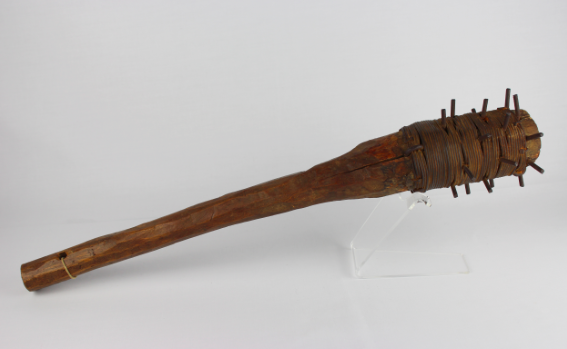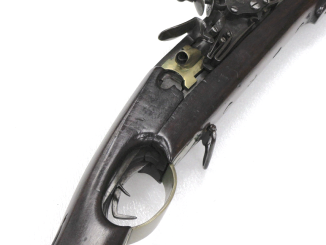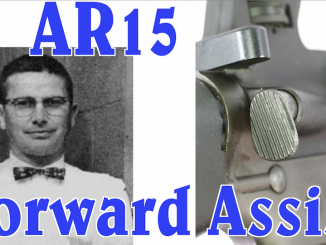John Browning developed the Browning Automatic Rifle for use by American troops in World War One, taking inspiration from the other light automatic weapons in service including the Chauchat, Lewis, and MG08/15. Rather than being used as a light machine gun as we would understand it today, the BAR was an “automatic rifle”, intended to be used in much the same way as the Germans would use the Sturmgewehr in WWII. It would be fired in semiautomatic mode from the shoulder or hip while advancing on the enemy, using steady fire to keep them pinned down. Once troops broke into close contact, the gun could be switched to fully automatic to provide overwhelming firepower for the final assault on a position. While the walking fire from the hip was not particularly realistic in practice, the fully automatic firepower was a huge boon to the infantry. While it filled the game role as the Chauchat, the BAR was a much more refined weapon and much easier to use effectively.
The BAR was showed tot he US Ordnance Department in 1917, and the first order for them was placed with Colt in July of 1917. In short order further contracts would be placed with Winchester and Marlin-Rockwell, although it would take many months to fabricate the production tooling and perfect the design for mass production. A few hand-fitted guns were ready in February 1918 for a public demonstration, but significant quantities were not being built until July of 1918.
These guns would be shipped to France for use by the AEF, but not actually put into combat service until the Meuse-Argonne offensive in late September of 1918, due to General Pershing’s desire to keep them secret from the Germans until a large number could be used at once. As a result, the guns saw only very limited use before the war ended on November 11th. In total 102,173 BARs would be built, about half of them being finished into 1919, after the armistice. They would go on the be changed and updated for use in World War Two, but that is a discussion for another day. This particular gun is an excellent example of an M1918 BAR in correct World War One configuration, which is a rare find today.




When I was being trained as a small arms repairman in Aberdeen Proving Grounds we were still being taught the BAR. I think they were issueing them to the South Vietnamese army. The instructor had a line I will never forget about the selector switch. He said the (S was for safe), the ( F was for fast) and the (A was for awful fast). I don’t know if that was his idea or if it came from a drill sgt back in the past. Anyway, it made it easy to remember for guys that had fired guns that were simply stamped F and S for hunting.
“Once troops broke into close contact, the gun could be switched to fully automatic to provide overwhelming firepower for the final assault on a position”
Similar idea was behind Fyodorov’s Avtomat (mostly used as self-loading, full-auto at short distances)
Secret weapon? What a laughable idea. The initial production batch was made with tons of dimension errors, which would render the rifles useless in battle! And would the German soldiers not attempt to get a counterpart before the M1918 showed up? Flame troopers used captured Chauchat rifles for lack of a domestic equivalent of fire support on the go (and the Madsen was too expensive, since it was an imported weapon with import fees added to the price tag)! The idea of a portable automatic weapon was not foreign to Germany. So if Pershing was afraid of reverse engineering, that fear was irrational! Otherwise we’d have to hide lots of other conventional weapons even from our own soldiers.
“Secret weapon? What a laughable idea.”
I don’t agree, secret weapon is secret once, after first use (or getting info via spy) it is not longer secret. Some weapon are effective if secret, example from First World War might be chemical weapon, which were lethal, but might be turned much less effective with usage of gas protection equipment. Thus the main reason for secret in secret weapons is to make enemy lacking in countermeasures.
“would the German soldiers not attempt to get a counterpart before the M1918 showed up”
This is main reason for reason; they can’t be looking for counter-part of something they did not know to exist.
“Madsen was too expensive, since it was an imported weapon with import fees added to the price tag”
Also, Madsen technology of production was not cheap.
There’s a world of a difference between the first use of tanks and gas attack (never before seen, and a complete surprise to the enemy) and a very heavy automatic rifle/very slow light machine gun! There is nothing the Germany Army would have done different had they known they were facing BAR armed units; it would have been little different to facing Chauchat armed units!
Exactly the point. The German soldiers already encountered automatic rifles (Chauchats) used by the French, so they wouldn’t have been very shocked to find similar weapons wielded by Americans.
Only, the Chauchat wasn’t quite similar, was it? The BAR actually worked as an automatic rifle that could be fired from the shoulder, on the move. The Chauchat, not so much.
When Ian gets his Chachat, it might be interesting to see him try it out, compared to a BAR, in a two-gun match setting. My guess is that the Chauchat is going to look a lot more like an LMG than the AR role that the BAR fills, and that the Chauchat is actually more of move-fire-from-the-prone affair than is the BAR.
A lot of the reports and discussions at the time indicated a certain… Dissatisfaction with the Chauchat, on the US side. The French were all hepped up on the “walking” fire idea, but the Doughboys doing the training at the time noted that the Chauchat wasn’t actually well-suited to the role. The Chauchat seemed to work best as a team weapon, with one guy carrying and firing it, and another doing the spotting, magazine handling, and so forth. By contrast, the BAR was a true one-man show, and like Ian demonstrated with the Colt Monitor the other day, damn near filling the role of a modern assault rifle.
As Ian points out with the examples of the tank, the flamethrower, and poison gas, limited initial experimental use had the problem of showing the enemy your cards. That Pershing made the choice he did in this case actually argues to him paying attention to the course of the war, and not repeating the mistakes of the French, Germans, and British. It’s actually pretty smart, when you get down to it.
The question of whether or not the BAR was a game-changer? Well, we’ll really never know–The 1919 offensives never took place. The conventional “verdict of history” is that it wasn’t that big a deal, but that’s from the standpoint of the here-and-now, where we’ve seen the StG-44 in use, and a host of other weapons. Today, the BAR would be a hum-drum everyday weapon of war–At the time, it was truly unique.
And, given that Pershing didn’t get to read “the verdict of history” in his briefing papers on the BAR, I’m gonna hold back on criticizing him. From the standpoint of “Hey, this could be big…” he had to work from at the time, it’s not too surprising he did what he did. They also did the same damn thing with the Pedersen Device, which was supposed to work in concert with the BAR. You put the two together, and imagine the synergistic effect of the Germans meeting both together with the new-ish assault tactics, the fresh, unjaded US troops carrying them, and I think you could be forgiven for doing exactly what Pershing did.
Most historical counterfactuals ignore how things looked to the participants at the time, who were doing as we would do, faced with a Chinese quantum communications array in a Pacific naval battle. In thirty years, when the technology is well-understood, the decisions of the here-and-now will look horribly ill-judged–But, they’re gonna be the best we can do at the time.
I agree, was Pershing unaware that the Germans had been fighting men with Lewis guns and Chauchats for years?
The idea that they would reverse engineer the BAR is also absurd. The German war economy was creaking at the seems. Ultimately, that was why they lost. The idea that they would take time and materiel to try and copy an American automatic rifle is absurd. If the Germans had wanted a gun like the BAR, they had had years to make one for themselves. They were more than capable, they invented the SMG after all.
The Germans had been fighting guys with LMGs for years, not guys with actual Automatic Rifles and the Pedersen Device, which would have possibly been as effective as an SMG. The combined pairing of those weapons would have been a much different thing than dealing with a single Lewis gun in every section.
It wasn’t so much the idea that the Germans would copy the gun, but that they’d copy the idea behind it, and/or find an effective countermeasure. In the window between where they first encountered it and created the countermeasure, Pershing hoped to end the war.
If you’ve ever looked over “Plan 1919”, which was the Allied plan for a grand combined offensive, one gets a picture of what he was going for, which would have been a mostly foot-borne version of Blitzkrieg long before the Germans did it in 1940. I can’t blame him for wanting every advantage possible.
Kirk:
I have much more sympathy for keeping the Pedersen Device secret, that really was a new development.
I am well aware of Plan 1919, and I wish it had been put into practice, because it would have finished the Germans off once and for all.
Because they accepted an armistice in November 1918, the likes of Hitler were later able to claim they had not really been beaten, but had been “stabbed in the back” instead. In fact, the German economy was shot by then, and the war was lost. But if the Great War had lasted into 1919, there may never have been a re-run in 1939-45.
“Because they accepted an armistice in November 1918, the likes of Hitler were later able to claim they had not really been beaten, but had been “stabbed in the back” instead.”
None could say what would happen, result might be different that excepted, cf. one video game https://en.wikipedia.org/wiki/Command_%26_Conquer:_Red_Alert#Plot
Steve McQueen uses that model BAR and I believe that type belt in the movie The Sand Pebbles.
In that case, they would surely make “intervention” (to put it in modern US political-military phrase) in Russia (remember civil war, Western states were funding communist opposition?), and what a jolly place and time this 20th century would be.
But things are never that simple
The safety set-up makes sense now.
This Browning guy seems to know what he’s doing.
Also note the similarity between it and the safety arrangement on the AK.
I’m pretty sure that at least a part of the design philosophy there is that the designer wants semi-auto to be the first thing the likely panicked soldier hits with his large-muscle reflexes, upon encountering someone who needs shooting–And, that backing up to full-auto ought to be something he has to think consciously about.
It’s a design flaw I see in a lot of the new-ish 45 degree fire controls on modern weapons–The likely effect of someone lunging from “safe” to “full auto” when they are shocked and in dire necessity…? Yeah; they’re gonna be on full-auto from the get-go, when they probably should be on semi.
It’s kind of stunning, when you consider that Browning wasn’t a combat veteran, and likely never took one of his weapons out after “the most dangerous game” himself…
Today’s safety catches seem to assume good trigger discipline on the part of the user. This is never guaranteed especially if you’re under stress.
I suppose the “secret” makes sense if we are talking about introducing a new combat doctrine. But that’s only if the troops were properly trained on the usage of both the M1918 and the Pedersen weapons and only if your industrial base doesn’t make tons of errors. I suppose you hadn’t read that the first batch of Browning automatic rifles was marred by a lack of quality control and worker training (they apparently didn’t get some of the dimensions correct when making the receiver units). Let’s suppose you threw the flawed batch into combat without correcting the problems in feeding and cycling. What do you think would happen?
The suggestion that Pershing did not permit early use of BAR’s because, to start with, they seemed to have been made by a one armed blacksmiths, in between shoeing donkeys, is a much more likely reason for them not being used early than any backstory of secret weapons.
Didn’t Pershing also replace Lewis guns with Chachats?
The man just seems to not like reliable light Machine Guns.
Actually that wasn’t Pershing who did that but Crozier, who personally HATED Lewis and threatened to have him jailed (and publicly cashiered with malice) for insubordination (and alleged patent infringement upon Samuel MacClean’s machine gun)!
An irreplaceable part of small arms development – this is what BAR became. One thing is to evaluate full auto use from this kind of package, but overall the contribution of this design for S/A application is huge reaching all the way to MAG58.
I believe this is first time the BAR in its original form is shown. Again, thanks for an excellent presentation.
Just-like-the-late-19th-century-Mosin-Nagant-with-Archangel-stock-and-suppressor-upgrade, the BAR-1918 received a new-age facelift from Ohio Ordnance to make it the HCAR (Heavy Counter-Assault Rifle) with features like an AR-15-style pistol grip, scope rail, and Vltor telescopic stock.
“Assault rifle”? Come on, you know better than that.
Call me Old School but by definition an assault rifle doesn’t use a full size rifle cartridge as you point out yourself.